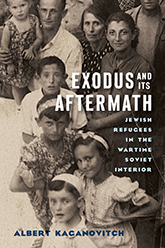|
Exodus and Its Aftermath
Jewish Refugees in the Wartime Soviet Interior
Albert Kaganovitch
“Drawing on a wealth of archival material, Kaganovitch shows that Soviet wartime and postwar propaganda about the warm embrace of evacuees by their fellow citizens masks a far more complex reality of hunger, disease, and discrimination.”
—Eliyana R. Adler, Penn State University
During World War II, some two million Jewish refugees relocated from the western regions of the USSR to the Soviet interior. Citizens in the Central Asian territories were at best indifferent—and at worst openly hostile—toward these migrants. Unpopular policies dictated that residents house refugees and share their limited food and essentials with these unwelcome strangers. When the local population began targeting the newcomers, Soviet authorities saw the antisemitic violence as discontentment with the political system itself and came down hard against it. Local authorities, however, were less concerned with the discrimination, focusing instead on absorbing large numbers of displaced people while also managing regional resentment during the most difficult years of the war. Despite the lack of harmonious integration, party officials spread the myth that they had successfully assimilated over ten million evacuees.
Albert Kaganovitch reconstructs the conditions that gave rise to this upsurge in antisemitic sentiment and provides new statistical data on the number of Jewish refugees who lived in the Urals, Siberia, and Middle Volga areas. The book’s insights into the regional distribution and concentration of these émigrés offer a behind-the-scenes look at the largest and most intensive Jewish migration in history.
Praise
“A welcome and informative addition to personal, professional, community, college, and university library Jewish/Russian/World War II history collections and for a supplemental curriculum studies syllabus.”
—Midwest Book Review
“Plumbs Soviet archives and published materials to provide considerable statistical data and compelling individual narratives of the plight of Jewish refugees in the Soviet interior. . . . Although the events of the Shoah overshadowed the predicament of these Eastern European Jews, Kaganovitch’s informed narrative reclaims their stories.”
—CHOICE Reviews
“A welcome contribution to the relatively limited field of wartime displacement in the USSR. Additionally, the book provides a fresh look at the history of Jewish people in the Soviet Union during World War II by examining the war’s impact on Jewish refugees from the USSR’s western regions to its east.”
—H-Russia
“Rich with examples from memoirs and a multitude of archival materials, which are accompanied by much statistical data, based on large-scale quantitative studies. All of these sources give a detailed picture of the situation regarding the places where Jewish refugees arrived.”
—AJS Review
“A long overdue landmark study of the refugee crisis in the wartime Soviet Union. . . . This is by far the best available study of the experience of flight, evacuation, and return.”
—Antisemitism Studies
|

Larger images
New in Paperback!
December 2023
LC: 2021009803 DS
336 pp. 6 x 9
2 b/w illus, 1 map, 20 tables
|

